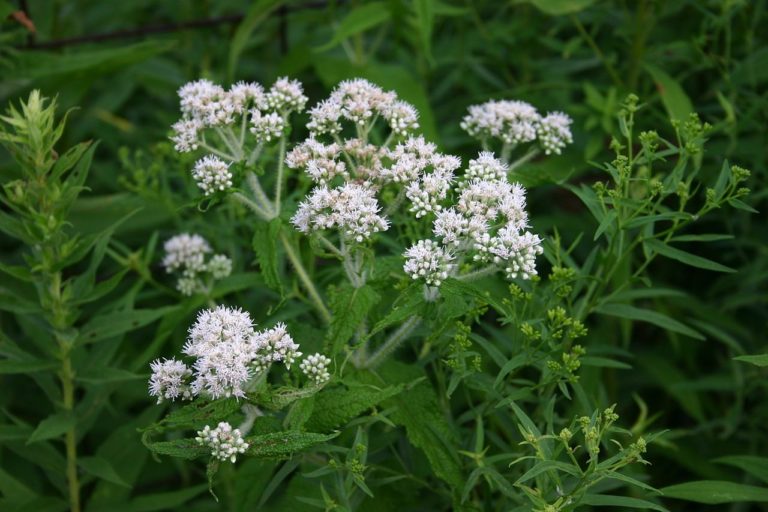Boneset or Thoroughwort is a hardy perennial which is found throughout the Eastern half of North America in sunny, low, wet roadsides and fields. The plant grows three to four feet in height with multiple, hairy stems branched only near the top. These terminate in bright white clusters, up to eight inches across, of ten to twenty aromatic florets. Boneset’s leaves are coarse, pointed, and arranged in pairs (opposite arrangement) with the bases joined so that the stem appears to grow through them (perfoliate). It is not fussy about its soil, and spreads by rhizomes as well as by its wind-borne seeds. There are many internet references to Boneset’s use as a folk remedy, “probably no plant in American domestic practice having more extensive and frequent use” (Botanical.com). Boneset’s flat-topped flowers in August/September attract a wide range of pollinators (bees, moths, butterflies, wasps, beetles) like its famous cousin, Joe-Pye weed, and the leaves are larval food for various Lepidoptera.
NURSERY HOURS
Wednesday: 10-4 Thursday: 10-6 Friday-Saturday: 10-4 Sunday: 12-4
Eupatorium perfoliatum

Key Info
Scientific Name: Eupatorium perfoliatum L.
Common Names: Boneset, American Boneset, Thoroughwort, Agueweed, Feverwort, Sweating-plant, Indian Sage, Teasel, Vegetable Antimony
Family Names: Asteraceae (Composite, or Daisy Family)
Plant Type: Herbaceous perennial
Flower Color: White
Special Characteristics: Good cut flowers, Tolerates some flooding, Attracts bees, Fragrant flowers, Attracts butterflies, Rhizomatous
Additional Info
Habit: Large, upright, clump-forming perennial with unbranched shoots except for floral side shoots near the apex, with hairy stems and leaves and fibrous root system; rhizomatous. No overwintering basal rosette.
Height: 4'-6'
Spread: 3'-4'
Soil Conditions: Moist, organic, acid to alkaline pH; sandy, loam, clay; prefers well drained but tolerates some flooding.
Leaves: Opposite, lance-shaped, wrinkled, medium green leaves up to 8" long x 2" across with serrated margins. The bases of the opposite leaves are fused around the stem, a distinctive feature.
Flowers (or reproductive structures: Flat-topped clusters up to 8" across of flowerheads, each flowerhead consisting of up to 15 small, perfect, white disk florets; fragrant.
Fruit: Florets develop achenes with small tufts of hair to facilitate dispersal by wind, in late summer/early fall.
Natural Distribution: Alluvial woods, bogs, rich prairies
USDA Hardiness Zone: 3 to 8
USDA Wetland Indicator Status in NC: FACW
Pollination: Bees, butterflies and other insects
Wildlife Connections: The nectar or pollen of the flowers attracts many kinds of insects, including bees, flies, wasps, butterflies, and beetles. Caterpillars of various moth species are known to feed on vegetative parts. Foliage is too bitter to attract mammalian herbivores. (Illinoiswildflowers.info)
Propagation: By seed (sow heavily as there is low germination) or by clump division in fall.
